About 30 years ago, osteochondrosis was connected exclusively with people of advanced age, whose joints are inactive and injured with every movement. However, times have changed. Nowadays, more and more people are changing the hard physical work for sitting on the computer, they are less and less monitoring the quality of the food, and more and more often meet the osteochondrosis of the Hotel cervix. No wonder that osteochondrosis is referred to as the "illness of the century", and almost every person who has reached the age of 25 meets the symptoms of this disease.
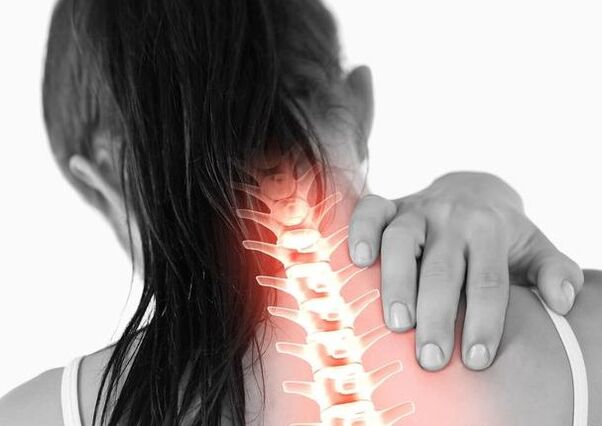
This is an insidious disease that, with unpleasant pain in the neck, very quickly to serious consequences in the form of hearing and visual weakening as well as a deterioration in memory until it is completely lost. For this reason, every person should know the causes of osteochondrosis and consult a doctor in good time in the event of unpleasant symptoms of the disease. We will talk about you in this article.
The causes of osteochondose of the cervix region
Paradoxically, all of our problems with the cervical spine begins in early childhood or rather in primary school, where the child develops for attitude and scoliosis. At this moment, the system of maintaining the vertebral head is violated, in particular the most subtle and vulnerable department - the cervix. The second key factor in the osteochondrosis of the cervix region, which starts in distant childhood, is inadequate physical preparation, in particular the weakness of the spine muscles and the so -called muscle corset, which supports the spine.
These are two most important causes of the disease. The rest with a severe load falls on a weakened spine and provokes the development of the disease in fairly young and healthy people. First, they include a seated lifestyle and lack of physical activity, especially the work associated with a long stay in a position. This is most characteristic for the driver and office worker and replaces on the computer. All of this is supplemented by an excess body weight that seriously increases the load of the spine.
It should be distinguished from the other causes of osteochondose of the cervical spine:
- Transmitted spine injuries;
- Metabolic injury;
- hereditary disposition;
- Great physical exertion;
- constant nervous tension and stress;
- Anomalies in the development of the cervical spine;
- Bad habits (keep the phone tube with ear and shoulder).
The development process of osteochondrosis
The listed adverse factors ultimately lead to an increase in the load of the cervical spine. When trying to compensate for the excess strain on the neck muscles, your cramp occurs, which leads to a violation of the blood circulation in this area and a decrease in metabolic processes. All of this is transformed into the development of degenerative processes in the spine. First, the vertebrae get thinner and get closer and press out their contents (fiber ring) outside the spine. Such a lead in the language of the doctors is called the lead.
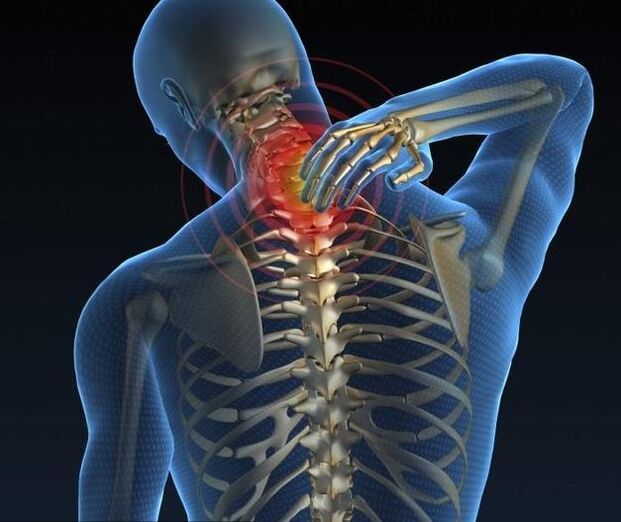
In the case of the advantage, the fibrous ring still retains its integrity, but the lead is already pressing the blood vessels and nerves that pass along the spine and feed the brain. In addition, converting and deforming vertebrae begins the roots of the peripheral nerves, which leads to the development of the so -called "radicular syndrome", which is manifested with severe pain in the back and neck. If you do not identify the problem (which signal unpleasant symptoms eloquently) and do not begin with the treatment of osteochondrosis, the fibrous ring will break and the vertebral hernia will appear. In this case, serious problems with brain nutrition occur.
Symptoms of a neck osteochondrosis
In its development, the disease pursues several stages, each characteristic characteristics and symptoms. It should be noted here that the osteochondrosis of the cervical spine differs from degenerative changes in other parts of the spine. The distances between the vertebrae are minimal, and therefore even small degenerative changes cause unpleasant symptoms and lead to various complications.
Osteochondrosis of the 1st degree.This is the preclinical stage of the development of the disease, in which the patient experiences slight pain and symptoms as well as tensions and rapid tiredness in the neck and back with an extended finding in a position (often in the seating) during the headwing. At this stage, osteochondrosis is treated perfectly with a change in lifestyle, nutritional correction and regular physical exercises.
Osteochondrosis of the II degree.At this stage there is instability between the vertebrae in the neck. In this case, a person with intensive pain is faced with the shoulder, neck or hand. During the inclinations or heads, the pain changes significantly, since the nerve endings begin to violate the nerve endings due to a decrease in the distance between the vertebrae. The patient quickly begins too tired, his performance is reduced, distraction, forgetfulness and headache ages.
Osteochondrosis of the III degree.With the insertion of the third stage of the disease, the pain in the back and neck becomes even stronger, the mobility of the neck decreases significantly, and a crunch of vertebra can be heard when the neck is turned. At night the patient begins to become deaf with his fingers (mainly a little finger and ring finger), which is why one person wakes up several times a night. During the day, such patients have an unpleasant severity in their hands. And even a short conversation on the phone in which a person is forced to keep a cell phone near his ear, turns into unpleasant tingling and numbness. All of this indicates an increase in the advantage and possibly towards the appearance of a hernia in the cervix region.
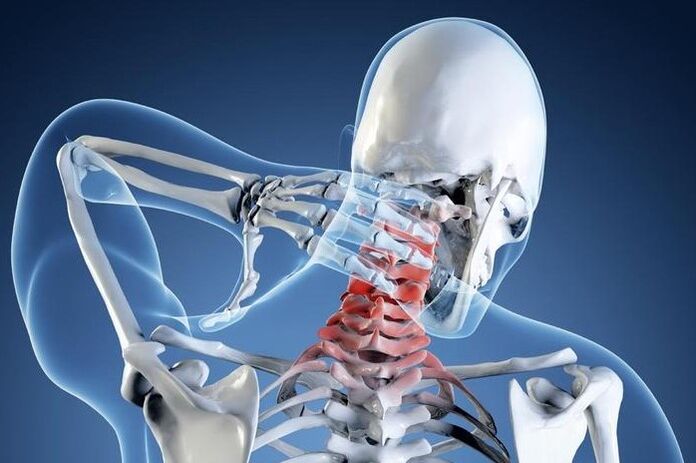
Osteochondrosis of the IV degree.In the last stage of the disease, the vertebrates are destroyed, which no longer perform their functions and are replaced by connective tissue. A patient in this state can observe a violation of the movement coordination, a noise appears and the pulsation in the ears is crazy, headaches are improved, visual acuity and hearing are reduced. In some cases, deafness of the language can be observed.
It should be said that the blood flow is disturbed to the brain due to the transmission of blood vessels. For this reason, the patient has neurotic disorders such as insomnia, nervousness, irritability and resentment, frequent mood swings and the inability to concentrate. Outbreaks of anger or fear can occur regularly to attack longing and depression.
In the later stages of the development of osteochondrosis, the strongest cramps of blood vessels can lead to the occurrence of "flying" in front of the eyes, a feeling of instability on a hard, flat surface, severe dizziness, migraine, nausea, vomiting and more frequent.
Diagnosis of the disease
In order to identify the cause of the pathology, the patient describes the unpleasant symptoms of the doctor of his condition. After hearing the patient, the specialist sends him to one of the following research methods.
Radiography.This diagnostic method is currently considered uninformative, especially in the last phases of the development of the disease.
Ultrasound -Duplex scanning.This method is used in cases in which a specialist contains a violation of blood flow in the arteries that give the brain of food. The study shows the blood flow rate and determines whether there are obstacles on its way.
CT (computer tomography).This method is more informative compared to radiography, since not only the problem shows, but also the presence and size of hernia determine, even though they have difficulties.
MRI (magnetic resonance imaging).The most informative method for diagnosing osteochondrosis, with which you can recognize the bone structures, the presence of hernia and even the direction of their development.
Treatment of osteochondrosis
We will immediately say that you should contact a neurologist to fight such a serious problem as osteochondrosis of the cervix region. If the clinic has a doctor in a vertebrologist, it is better to contact him first. You can only treat osteochondrosis comprehensively. The complex of the methods used includes drug therapy, massage of cervical zone, training therapy, physiotherapeutic methods and proper nutrition. Only the combination of all of these methods helps to cope with the disease and normalize the patient's borehole.
Help with severe pain
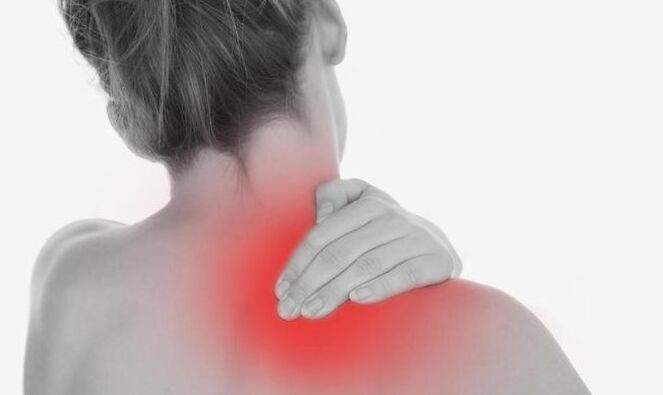
In the event of severe pain syndrome, doctors recommend taking analgesics. If these funds stop bringing relief, you can switch to non -steroidal anti -inflammatory medication.
In general, drug therapy includes the following means:
- NSAIDS (non -steroid anti -inflammatory medication). These products remove pain, relieve swelling and cope with inflammation of the nerve roots.
- Chondroprotectors. Such drugs restore damaged cartilage tissue perfectly.
- B -Vitamine B. They are necessary to improve the metabolic processes in nerve tissues.
- Musorelaxants. The effect of these medication aims to reduce muscle cramps.
- Preparations that improve the rheological properties of blood. Thanks to such agents, the flow of oxygen and nutrients improve to the brain and the end of the nerve.
It should be noted here that it is possible to only achieve a concrete effect in the fight against osteochondrosis using ointments and tablets if treatment with medication is combined with other therapy methods. Otherwise, the medication will only achieve a temporary effect.
Many experts tend to treat osteochondrosis with injections in order to quickly influence the nerve endings and to save the patient from taking tablets from possible side effects. However, vitamins are best taken orally, since vitamins from the body are well absorbed by the body with every adoption method, but injections with them can be painful.
Physiotherapeutic treatment methods
Treatment with medication must be combined with physiotherapy therapy methods. The most effective in this disease are taken into account:
- Electrophoresis (in combination with medication). In this case, medication penetrates under the influence of the electrical current damaged vertebrae.
- Ultrasonic. With this exposure method you can relieve the inflammation process, calm pain and improve the metabolic processes in the tissues.
- Magnetotherapy. This type of physiotherapy relieves swelling and eliminates pain.
- Laser therapy. This is a great method for combating inflammatory processes that also improves blood circulation.
Diet for osteochondrosis
The restoration of the affected vertebrae also includes a special diet that normalizes the metabolic processes in the body, prevents the deposition of salts, nourishes and restores the cartilage tissue and also reinforces the ligaments between vertebrates.
To achieve this, the patient's diet should first be excluded:
- Alcoholic drinks;
- fat and fried dishes;
- Sharp and too salty dishes;
- Strong brewing;
- Weaknesses and Sdoba;
- Strong tea and coffee;
- Cucumber and marinades;
- Provisions.
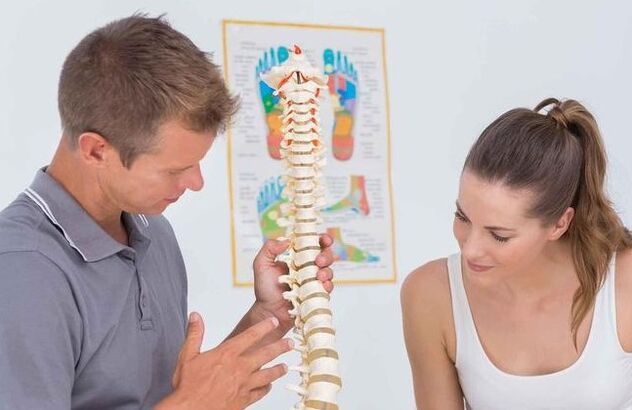
The diet of a patient with osteochondrosis should consist of the following food:
- Low -fat meat and fish;
- Low -fat milk, cottage cheese and kefir;
- Butter (in small quantities);
- Muesli and soups from entire grain;
- Jellies, flock from fish or meat;
- Vegetables, fruit and berries;
- Juices, fruit drinks, jellies and compotas.
When localizing osteochondrosis in the cervix region, it is important to adhere to the drinking regime and drink at least 1, 5 liters of water a day. If it is overweight, you should think about how you can get rid of additional pounds that offer the additional load on the spine. It is advisable to get electricity in small portions 5 times a day.
At the same time, as can be seen from the list of products approved for use, the basis for food, vegetarian soups, cooked, fat -free meat, fish, seafood, unsweetened vegetables and fruit should be.
The approximate menu for the day looks like this:
- Breakfast: cottage cheese, pair of apples, tea without sugar;
- Lunch: Backbear, a little oatmeal;
- Lunch: vegetarian borsch, cooked chicken with vegetable salad;
- Afternoon snack: dry cake and fruit fruit fruit;
- Dinner: baked fish with vegetables and tea without sugar.
Exercise therapy for osteochondrosis
Sports lessons provide amazing results in the treatment of osteochondrosis. It is important here that the patient has no complaints and pain in the process of massage or gymnastics.

Here are some most effective gymnastics exercises that aim to strengthen the cervical muscles and improve blood circulation in this area.
Exercise number 1Lying on the stomach and letting her hands on the floor, slowly raising your head and upper body so that the back stays straight. Keep for 1 minute in this position and then return to the starting position. The element is repeated 2-3 times.
Exercise number 2Lying on your stomach and expanding your hands along the body, raising your head slightly and turning it to the right, try to touch the floor with your ear and then to the left. Perform 6 curves in each direction.
Exercise number 3If you sit on the floor, be inspired, tilt forward, try to reach your chin to the chest, return to the starting position to exhale and throw your head back. Repeat the element 10-15 times.
Exercise number 4Attach your palms to your forehead and try to put pressure on your head with an effort. At the same time, strain the muscles of the neck, resist their hands and prevent the head. Keep the pressure long for 20 to 30 seconds, then lower your hands and relax. Repeat the element 2-3 times and repeat the exercise in the opposite direction and give your handle hands on the back of the head.
Exercise number 5Slowly turn your head to the right and left and try to look behind your back. Make 10 curves on each side. Sound Health!














